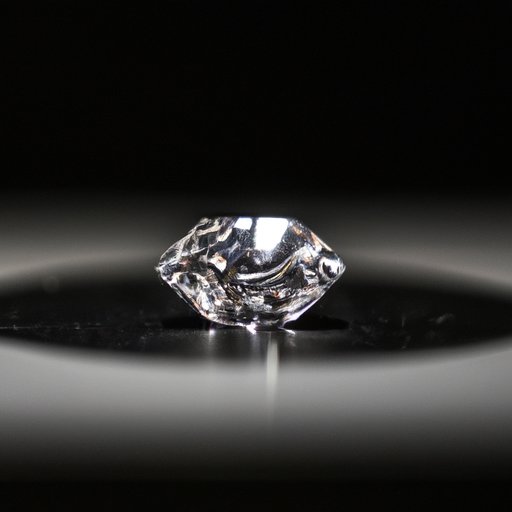Introduction
A diamond is a precious gemstone that has been admired for its beauty and strength since ancient times. This sparkling gemstone is composed of carbon, and is known to be the hardest naturally occurring material in the world. But what else is a diamond made of? In this article, we will explore the chemical composition, formation, mining and cutting processes, types, and rarity and value of diamonds, so you can better understand what makes up this precious gemstone.

Chemical Composition of a Diamond
Diamonds are composed primarily of carbon atoms, which make up its strong crystalline structure. The atoms are arranged in a tetrahedral lattice, where each atom is bonded to four other atoms at the corners of a cube. This arrangement gives diamonds their incredible strength, making them the hardest natural material on Earth.
In addition to carbon, diamonds may contain trace amounts of other elements such as boron, nitrogen, hydrogen, and oxygen. These elements give diamonds their unique colors and properties, such as blue and pink hues.

Geology of a Diamond and its Formation
Diamonds are formed over millions of years deep within the earth’s mantle, where temperatures reach up to 1,300 degrees Celsius. Extreme pressure and heat cause carbon atoms to bond together to form a diamond crystal structure. These crystals then move upward through volcanic activity, where they are deposited in kimberlite pipes or alluvial deposits.
Diamond mines are located in many countries around the world, including South Africa, Australia, Canada, Russia, and India. Each country produces diamonds of varying qualities, with some being more sought-after than others.
How Diamonds are Mined and Cut
Diamonds are mined using two primary methods: open-pit and underground mining. Open-pit mining involves digging a large hole in the ground and extracting diamonds from the ore. Underground mining involves digging tunnels and shafts to access deeper layers of ore.
Once diamonds have been extracted from the ground, they must be cut and shaped into the desired shape. This process involves grinding away the rough edges of the diamond until it is the desired size and shape. After cutting, the diamond is polished to a high shine.
The Different Types of Diamonds
Diamonds come in many different shapes, sizes, colors, and clarity grades. Color is determined by the presence of trace elements such as nitrogen, while clarity is determined by the number and size of inclusions, or impurities, in the stone. Carat refers to the weight of the diamond, and is often used to measure the size of the stone.
Other factors that affect the quality of a diamond include its cut, polish, and symmetry. These determine how much light a diamond reflects, which affects its sparkle and brilliance.

The Rarity and Value of Diamonds
The rarity and value of diamonds are determined by a variety of factors. Color, clarity, carat, cut, and polish all play a role in determining the value of a diamond. Other factors such as lab-grown diamonds, synthetic diamonds, and treatments can also affect the value of a diamond.
The supply of diamonds is limited and demand is high, which makes them rare and valuable. As diamonds become increasingly scarce, their prices are likely to increase, making them even more desirable.
Conclusion
In conclusion, a diamond is composed primarily of carbon, with traces of other elements giving it its unique color and properties. Diamonds are formed under extreme pressure and heat in the earth’s mantle, and are found in diamond mines around the world. They are mined and cut into various shapes and sizes, and their rarity and value depends on a number of factors.
We hope that this article has helped you understand what is a diamond made of. From its chemical composition to its rarity and value, diamonds are truly one of nature’s most remarkable creations.


